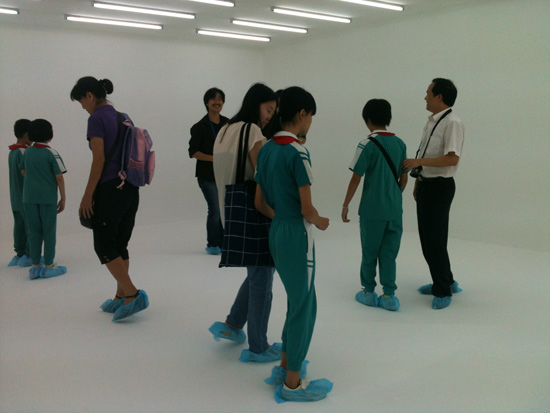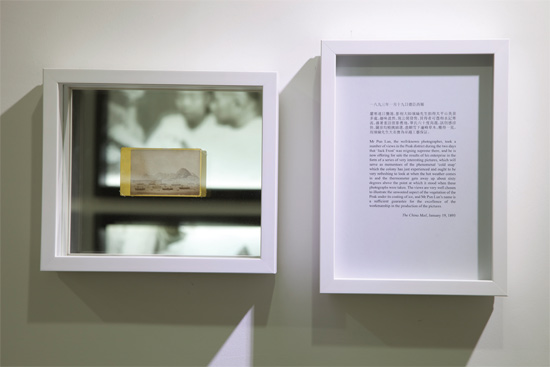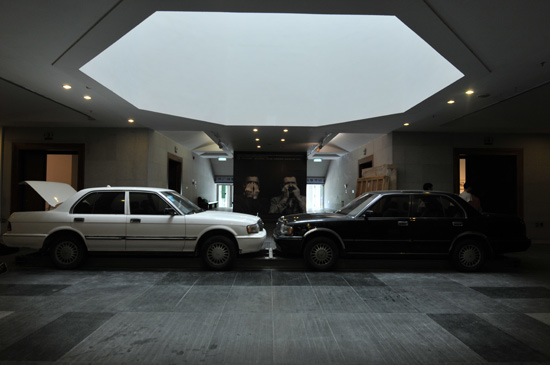|


By Cristina Sanchez K
The fourth edition of the Guangzhou Triennial, celebrating its 10th year, is
mainly set in the bunker-style Guangdong Museum of Art building, displaying an
impeccable spatial occupancy within the dry interiors of the museum, including
some odd corridors and bathrooms. It’s a very formal show based around a candid
theme: the Unseen. As the subject itself could potentially be quite generic, it
is what is unseen that has the power to carry meaning and value both
conceptually and aesthetically. Through the works of about 75 artists and their
skill at conceptualising the immaterial, the exhibition manages to establish a
solid theoritical base with a dash of unpredictability and something of the
conventional, but also demonstrates openness to some of the artists’
experimentations.
Curators Jiehong Jiang (from China, director of the Centre for Chinese Visual
Arts at the Birmingham Institute of Art and Design) and Jonathan Watkins (from
the UK, director of the Ikon Gallery, a registered educational charity, in
Birmingham) chose works by artists of all ages and levels of recognition,
working with sound, painting, video, installation, sculpture, drawing,
calligraphy, performance and film. They come with a varied collection of
intellectual approaches and standpoints but all have in common practices that
have to be approached and perceived at a intellectual and spiritual level. The
exhibition spans over the museum, the Guangzhou Opera House and the Grandview
Mall, one of the largest shopping centres in Southern China.
The unseen is therefore nested in the materiality of the artistic media such
as in paintings or sculptures or installations. The subject of painting as a
medium and its limits is formally explored throughout the works of Ron Terada
(b.1969) and Amikam Toren (b.1945). The former considers the subject of
representation and objects ? referencing Andy Warhol’s Brillo boxes, as Watkins
points out ? with Who I Think I Am (2011) from the artist’s recent exhibition at
Ikon Gallery. The work is made of replicas of boxes delivered for the exhibition
at Ikon with the artist’s name and the address of the gallery.
As for the latter, Toren cuts stencilled letters out of landscape paintings
cheaply bought in second-hand shops to recreate catchy sentences from songs and
commercials; he also cuts out the original signatures out of similarly acquired
oil paintings and then frames them on cardboard that he signs with his own
name.
But the unseen ? and the subjects of originality, copyright and intellectual
ownership ? resides as much in the immaterial realm as it does within the media,
through an offbeat sense of humour or performative actions that borrow from
film. Such is the case in the works of Ceal Floyer (b.1968) who screens Untitled
Credit Roll (2012), a movie end-credit sequence with out-of-focus, unreadable
names; or the works of Graham Gussin (b.1960), who renders reality into science
fiction such as in the film Spill (1999, 2006), which draws from feathers, dust,
wind and fumes pervasively unfolding as in a extraordinary narrative in an
ordinary urban setting. In Sofia Hulten’s (b.1972) video Immovable
Object/Unstoppable Force (2005), human characters stand in front of a truck and
as in an educational yoga video direct the viewer to do things, such as
“visualise that your energy is blending with the object”.
At the end of a hallway, three small windows discreetly display the stunning
poetic works of Rikuo Ueda (b.1950), constructed machines that suspend pencils
and brushes so that when they’re left in the wind, they create wind-made
calligraphy.
Nothingness within an urban context can testify of the passing of time, as an
organic body leaves traces of its evolution behind through body fluids, hair and
fingernail scrapings. Testimony to this is found in Ignasi Aballi’s (b.1958)
works ? in the form of footprints on white walls in People (2000-2012), and in
comments written in grey dust on the two-cubic-metre glass installation Vitrine
(dust-grey) (2012). Curator Jonathan Watkins says that “the exhibition reflected
on the ideas of different layers of reality and spirituality, on the hidden and
what is invisible”. Of Aballi’s work he says that “people often don’t pay
attention to dust, which is a rich substance”, and notes the realism of the
work.
The presentation of the art within the museum is particularly worth
mentioning, as it enhances the aura of each work within the given constraints of
the museum. “The design of the space started right from the beginning when we
were formally nominated as curators of the show back in late 2011,” says Jiang.
“When we think of a new artist participating, a new piece of work, then we think
of the space automatically,” noting that the final decisions were still
happening 24 hours before the opening as the team was “trying very hard to work
out the best place for each individual work and present them in the
architectural context”. He also mentions that they have declined suggestions
from the museum such as categorising all the works into different thematic
sections for all the different gallery spaces, instead telling the visual story
as a whole. “‘The Unseen’, to me, is not necessarily thematic, but
methodological.”
Moscow-based Russian artist Vladimir Arkhipov (b.1961), who has been
collecting, replicating and documenting folk utilitarian handmade tools for more
than two decades, spent two weeks prior to the opening of the triennial sourcing
material from Chinese farmers, street vendors and merchants, interviewing them
in the process and marvelling at the inventiveness of some of the local designs.
They add to his ongoing Post Folk Archive collection of DIY tools, comprising
hundreds of low-cost models from resourceful Russian and other self-taught
inventors.



A little belle-époque perversion is found in the small illustrative drawings
of Marcel Dzama (b.1974), while in the paintings of Tim Johnson (b.1947) Buddhas
mix with aboriginal dreamtime and flying
saucers.共2条 共2页 第一页 上一页 下一页 最后页 | 

